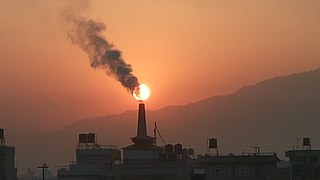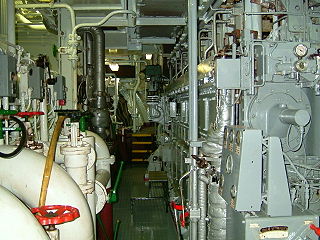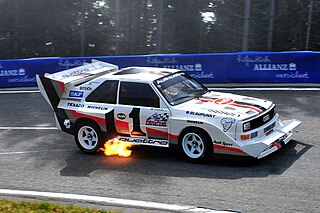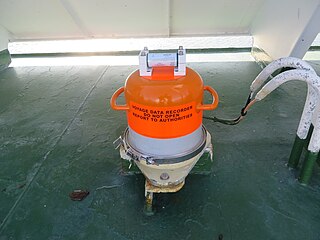Related Research Articles

The diesel engine, named after the German engineer Rudolf Diesel, is an internal combustion engine in which ignition of the fuel is caused by the elevated temperature of the air in the cylinder due to mechanical compression; thus, the diesel engine is called a compression-ignition engine. This contrasts with engines using spark plug-ignition of the air-fuel mixture, such as a petrol engine or a gas engine.

The International Maritime Organization is a specialised agency of the United Nations responsible for regulating maritime transport. The IMO was established following agreement at a UN conference held in Geneva in 1948 and the IMO came into existence ten years later, meeting for the first time on 17 March 1958. Headquartered in London, United Kingdom, the IMO, in 2024, has 176 Member States and three Associate Members.

A two-strokeengine is a type of internal combustion engine that completes a power cycle with two strokes of the piston in one revolution of the crankshaft. In a two-stroke engine, the end of the combustion stroke and the beginning of the compression stroke happen simultaneously, with the intake and exhaust functions occurring at the same time.

The International Convention for the Prevention of Pollution from Ships, 1973 as modified by the Protocol of 1978, or "MARPOL 73/78" is one of the most important international marine environmental conventions. It was developed by the International Maritime Organization with an objective to minimize pollution of the oceans and seas, including dumping, oil and air pollution.

USS Narwhal (SSN-671), a unique submarine, was the third vessel of the United States Navy to be named for the narwhal, a gray and white arctic whale with a unicorn-like, ivory tusk.

On a ship, the engine room (ER) is the compartment where the machinery for marine propulsion is located. The engine room is generally the largest physical compartment of the machinery space. It houses the vessel's prime mover, usually some variations of a heat engine. On some ships, there may be more than one engine room, such as forward and aft, or port or starboard engine rooms, or may be simply numbered. To increase a vessel's safety and chances of surviving damage, the machinery necessary for the ship's operation may be segregated into various spaces.

Power Stroke, also known as Powerstroke, is the name used by a family of diesel engines for trucks produced by Ford Motor Company and Navistar International for Ford products since 1994. Along with its use in the Ford F-Series, applications include the Ford E-Series, Ford Excursion, and Ford LCF commercial truck. The name was also used for a diesel engine used in South American production of the Ford Ranger.
This is a glossary of firefighting equipment.

A backfire or afterburn is combustion or an explosion produced by a running internal combustion engine that occurs in the exhaust system, rather than inside the combustion chamber. It is also sometimes referred to as an afterfire, especially in cases where the word backfire is used to mean a fuel burn that occurs while an intake valve is open, causing the fire to move backward through the system and out through the intake instead of the exhaust. When the flame moves backward it may also be called a "pop-back". A backfire can be caused either by ignition that happens with an exhaust valve open or unburnt fuel making its way into the hot exhaust system. A visible flame may momentarily shoot out of the exhaust pipe. A backfire is often a sign that the engine is improperly tuned.

Voyage data recorder, or VDR, is a data recording system designed for all vessels required to comply with the IMO's International Convention SOLAS Requirements in order to collect data from various sensors on board the vessel. It then digitizes, compresses and stores this information in an externally mounted protective storage unit. The protective storage unit is a tamper-proof unit designed to withstand the extreme shock, impact, pressure and heat, which could be associated with a marine incident.

The General Motors–Detroit Diesel V8 engine is a series of diesel V8 engines first introduced by General Motors for their C/K pickup trucks in 1982. Developed in collaboration with GM subsidiary Detroit Diesel, the engine family was produced by GM through 2002, when it was replaced by the new Duramax line. AM General's subsidiary General Engine Products (GEP) still produces a military variant of this engine for the HMMWV.

A velocity stack, trumpet, or air horn is a typically flared, parallel-sided tubular device fitted individually or in groupings to the entry of an engine's air intake system to smooth high speed airflow, and allow engine intake track tuning to incorporate pressure pulses created by its internal components.

A turbine engine failure occurs when a gas turbine engine unexpectedly stops producing power due to a malfunction other than fuel exhaustion. It often applies for aircraft, but other turbine engines can also fail, such as ground-based turbines used in power plants or combined diesel and gas vessels and vehicles.

An LNG carrier is a tank ship designed for transporting liquefied natural gas (LNG).

A unit injector (UI) is a high-pressure integrated direct fuel injection system for diesel engines, combining the injector nozzle and the injection pump in a single component. The plunger pump used is usually driven by a shared camshaft. In a unit injector, the device is typically lubricated and cooled by the fuel itself.
Marine diesel oil (MDO) is a type of distillate diesel oil. Marine diesel oil is also called distillate marine diesel. MDO is widely used by medium speed and medium/high speed marine diesel engines. It is also used in the larger low speed and medium speed propulsion engine which normally burn residual fuel. Those fuels result from a catalytic cracking and visbreaking refinery. Marine diesel oil has been condemned for its nimiety of sulfur, so many countries and organizations established regulations and laws on MDO use. Due to its lower price compared to more refined fuel, MDO is favored particularly by the shipping industry.
A double-walled pipe is a secondary contained piping system. It is a pipe within a pipe, or encased in an outer covering, with an annulus between the two diameters. The inner pipe is the primary or carrier pipe and the outer pipe is called the secondary or containment pipe. The great majority of double-walled piping applications involve wastewater, groundwater, and process safety.

The FSS Code or International Code for Fire Safety Systems is a set of international treaties organised by the International Maritime Organization (IMO) under the SOLAS Convention that are designed to reduce the risk of fire, and aid in emergency response aboard ships. Some of the components of the code were constructed after some high-profile passenger ship disasters over the last century.

CMA CGM Benjamin Franklin is an Explorer class containership built for CMA CGM. Delivered in November 2015, she is named after Benjamin Franklin, one of the Founding Fathers of the United States. She is one of the largest container cargo vessels, capable of carrying 18,000 TEU.

Heavy fuel oil (HFO) is a category of fuel oils of a tar-like consistency. Also known as bunker fuel, or residual fuel oil, HFO is the result or remnant from the distillation and cracking process of petroleum. For this reason, HFO is contaminated with several different compounds including aromatics, sulfur, and nitrogen, making emissions upon combustion more polluting compared to other fuel oils. HFO is predominantly used as a fuel source for marine vessel propulsion using marine diesel engines due to its relatively low cost compared to cleaner fuel sources such as distillates. The use and carriage of HFO on-board vessels presents several environmental concerns, namely the risk of oil spill and the emission of toxic compounds and particulates including black carbon. The use of HFOs is banned as a fuel source for ships travelling in the Antarctic as part of the International Maritime Organization's (IMO) International Code for Ships Operating in Polar Waters (Polar Code). For similar reasons, an HFO ban in Arctic waters is currently being considered.
References
- 1 2 "Resolution MSC.31(63), Annex 2" (PDF). IMO. 23 May 1994. p. 6.[ permanent dead link ]
- ↑ "Resolution MSC.201(81), Annex 1" (PDF). IMO. 18 May 2006. p. 2.[ permanent dead link ]